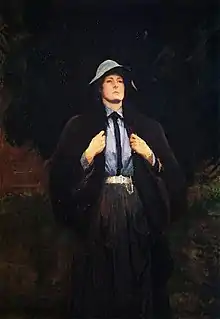Clementina Anstruther-Thomson
Clementina "Kit" Caroline Anstruther-Thomson (1857–1921) was a Scottish author and art theorist. She was known for writing and lecturing on experimental aesthetics during the Victorian era. Her collaboration with Vernon Lee in the 1890s inspired Lee's growing interests in the psychological aspect of aesthetics later in her career.[1]
Clementina Anstruther-Thomson | |
|---|---|
 Portrait of Clementina Anstruther-Thomson by John Singer Sargent (1889) | |
| Born | 1857 |
| Died | 1921 (aged 63–64) |
| Nationality | Scottish |
| Occupation | Author |
| Known for | Experimental aesthetics |
Early life
Anstruther-Thomson was born to John Anstruther-Thomson of Charleton and Carntyne, and Caroline Maria Agnes Robina Gray in an aristocratic family. Her grandfather, also John Anstruther-Thomson, was a career officer in the British Territorial Army.[2]
Experimental aesthetics
The aesthetic movement in the United Kingdom began in the 1860s during the Victorian period.[3] In Victorian literature, writers of the aesthetic movement focused on the sensual aspect of aesthetics.[4] Anstruther-Thomson in particular was keen on experiencing art physically with her body.[1] In one of the lectures titled "What Patterns Do to Us" given by Anstruther-Thomson, she encouraged the audience to engage with a patterned vase and "feel its effect on their bodies".[5]
Vernon Lee was already familiar with Anstruther-Thomson's work prior to meeting her. Contemporary writers have described Anstruther-Thomson as having the physique that resembles the ideals from ancient Greek sculpture, and Lee frequently described her obsession with Anstruther-Thomson's body in her writings.[6] When Lee observed art with Anstruther-Thomson, her aesthetic experience was based on "lesbian desire" of Anstruther-Thomson's body that embodied Greek ideals.[1]
Collaboration with Vernon Lee
.jpg.webp)
Anstruther-Thomson first met Vernon Lee in 1888, and for the next twelve years the two women openly lived together, as "lovers, friends, and co-authors".[7][8] Living as expatriates in Italy, they often travelled back and forth to Britain. In their time together, they took aesthetics experiments and recorded their findings. Throughout the 1890s, Anstruther-Thomson and Lee visited many museums across continental Europe and observed many art works. In their observation, they recorded in writing on how their body responded to art works.[9]
In 1897, they published the combined findings in the article "Beauty and Ugliness", which investigates the physiology of aesthetics. Their research was based on the James–Lange theory of how the human body responds to stimulation and triggers emotion.[10] Many of the findings, however, were not taken seriously as both their professional and romantic relationship was "attacked"[11] by their contemporaries, receiving "severe criticisms" from friends.[7]
Later life
After the publication of "Beauty and Ugliness", Anstruther-Thomson gradually drifted away from Lee, and eventually broke off the relationship in 1898.[8], remaining close friends.[7] She was subsequently in a relationship with the Welsh author and Chief Commissioner for Girl Guides in Wales, Hon. Fflorens Roch (1879-1969), the two were "rarely apart".[12]
Later in her life, Anstruther-Thomson worked closely with the Girl Guides Association. Many of the leaders were single women, and some were lesbian as well, for whom Guiding provided a safe refuge.[13] Anstruther-Thomson was both an organiser and trainer, and held the position of County Commissioner until her death.[13] She was buried with her family in Kilconquhar Parish Churchyard, Kilconquhar.[2]
Her writings on aesthetics were collected and published posthumously by Lee in Art and Man in 1924, with an introduction, also by Lee, that describes their collaboration in experiencing art.[14][15]
Personal views
Anstruther-Thompson was a humanist and a proponent of the British Ethical movement. She was a paid-up member of the West London Ethical Society, a predecessor group of Humanists UK, which later recalled her contributions as one of its "heroines of freethought".[16]
References
Citations
- Dellamora 1999, pp. 30–31.
- Mosley 2003, p. 644.
- MacCarthy, Fiona (26 March 2011). "The Aesthetic Movement". The Guardian. Retrieved 30 July 2017.
- Morgan 2017, p. 5.
- Morgan 2017, pp. 1, 228.
- Dellamora 1999, p. 34.
- York 2002, p. 93.
- Dellamora 1999, p. 32.
- Morgan 2017, p. 227.
- Martin 2013, p. 49.
- Dellamora 1999, p. 100.
- Jeal, Tim (2001). Baden-Powell: Founder of the Boy Scouts. Yale, USA: Yale University Press. p. 479. ISBN 030018672X.
- Proctor 2009, p. 57.
- Martin 2013, p. 76.
- Morgan 2017, p. 228.
- Goodall, Madeleine (20 November 2020). "Heroines of freethought: women of the early humanist movement". Humanists UK. Retrieved 3 December 2020.
Bibliography
- Dellamora, Richard (1999). Victorian Sexual Dissidence. Chicago: University of Chicago Press. ISBN 0226142264.
- Martin, Kirsty (2013). Modernism and the Rhythms of Sympathy. Oxford: Oxford University Press. ISBN 978-0199674084.
- Morgan, Benjamin (2017). The Outward Mind: Materialist Aesthetics in Victorian Science and Literature. Chicago: University of Chicago Press. ISBN 978-0226457468.
- Mosley, Charles (2003). Burke's Peerage, Baronetage & Knightage. Wilmington, Delaware: Burke's Peerage.
- Proctor, Tammy M. (2009). Scouting for Girls: A Century of Girl Guides and Girl Scouts. Santa Barbara: Praeger. ISBN 978-0313381140.
- York, Lorraine (2002). Rethinking Women's Collaborative Writing: Power, Difference, Property. Toronto: University of Toronto Press. ISBN 0802084656.